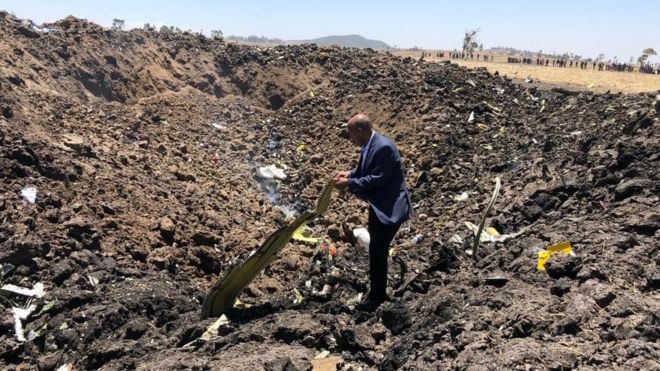An Ethiopian Airlines jet has crashed shortly after take-off from Addis Ababa, killing all on board. The airline said 149 passengers and eight crew members were on flight ET302 from the Ethiopian capital to Nairobi in Kenya.
It said 32 Kenyans, 18 Canadians, eight Americans and seven British nationals were among the passengers.
The crash happened at 08:44 local time, six minutes after the months-old Boeing 737 Max-8 took off.
Do we know how it happened?
The cause of the disaster is not yet clear. However, the pilot had reported difficulties and had asked to return to Addis Ababa, the airline said.
“At this stage, we cannot rule out anything,” Ethiopian Airlines CEO Tewolde Gebremariam told reporters at Bole International Airport in Addis Ababa.
“We cannot also attribute the cause to anything because we will have to comply with the international regulation to wait for the investigation.”
Visibility was said to be good but air traffic monitor Flightradar24 reported that the plane’s “vertical speed was unstable after take-off”.
An eyewitness at the scene told the BBC there was an intense fire as the aircraft hit the ground.
First word of the crash came when Prime Minister Abiy Ahmed expressed his “deepest condolences” on Twitter.
The airline said that search and rescue operations were under way near the crash site around the town of Bishoftu, which is 60km (37 miles) south-east of the capital.
Who are the victims?
Mr Gebremariam told the news conference that passengers from more than 30 countries were on board the flight.
He said they included 32 Kenyans, 18 Canadians, nine Ethiopians, eight Italians, eight Chinese, eight Americans, seven Britons, seven French citizens, six Egyptians, five Dutch citizens, four Indians and four people from Slovakia.
Slovak MP Anton Hrnko later confirmed via Facebook that his wife and two children were on the plane.
Three Austrians, three Swedes, three Russians, two Moroccans, two Spaniards, two Poles and two Israelis were also on the flight.
There was also one passenger each from Belgium, Indonesia, Somalia, Norway, Serbia, Togo, Mozambique, Rwanda, Sudan, Uganda and Yemen.
Four people held United Nations passports, the airline said, and it believed some passengers could have been heading to a session of the UN Environment Assembly which begins in Nairobi on Monday.
What do we know about the plane?
The 737 Max-8 aircraft is relatively new to the skies, having been launched in 2016. It was added to the Ethiopian Airlines fleet in July last year.
Boeing said it was “deeply saddened” by the crash and offered to send a team to provide technical assistance.
Another plane of the same model was involved in a crash five months ago, when a Lion Air flight crashed into the sea near Indonesia with nearly 190 people on board.
Investigators say the pilots of that aircraft had appeared to struggle with an automated system designed to keep the plane from stalling – a new feature of the Boeing 737 Max.
The anti-stalling system repeatedly forced the plane’s nose down, despite efforts by pilots to correct this, findings suggest.
There is no suggestion that the Ethiopian Airlines jet suffered similar issues on Sunday.
What about the airline’s safety record?
Ethiopian Airlines flies to many destinations in Africa, making it a popular carrier in a continent where many airlines fly only from their home country to destinations outside Africa.
It has a good reputation for safety, although in 2010 one of the company’s aeroplanes crashed in the Mediterranean Sea shortly after leaving Beirut.
The incident killed 90 people on board.
The airline’s highest fatalities prior to this came in a November 1996 crash during a hijacking on a flight from Addis Ababa to Nairobi.
One of the plane’s engines stopped when the fuel ran out and although pilots attempted an emergency water landing, they hit a coral reef in the Indian Ocean and 123 of the 175 people on board were killed.
Source: BBC
